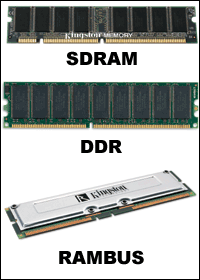DDR SDRAM MEMORY |
How to identify different sizes of computer memory RAM?You have a large collection of RAM modules - SIMMs and DIMMs, but you have no idea of how to identify the memory capacity in megabytes (MB) of the individual modules, and you want to know if there is any way to determine the size of a module other than by installing it on a motherboard in a computer that supports that type of RAM. It is possible to identify the chips by part number. You have to identify the size of each the chips on a module, and then multiply the size by the number of chips on the module to determine its memory capacity. Different RAM manufacturers have developed their own methods of identification, so it is has become difficult to identify the chips without looking up the exact part number on a website that provides the information. Luckily, the Internet has made doing this fairly easy via the Google search engine. Unless they have been remarked by unscrupulous dealers that are selling substandard modules not passed for use in a computer as computer-quality, all of the chips on a particular module will have the manufacturer's name (or logo), and a part number printed on them. For example, a 30-pin SIMM module with nine chips on the module, could have the part number - KM41C4000AJ-8. Drop the AJ-8 (the first letter is usually the quality - A, B, C, etc.), then use KM41C4000 to conduct a Google search. You should be provided with links to many sites that provide information about part numbers. One of them is http://www.memoryusa.com/guide.html. The KM indicates parts made by Samsung. The 41 indicates that it is a 1Mbit x 4 part. This means that the chip holds 4Mbits. Eight of the nine chips hold memory, so this is a 8 x 4Mbit, or 32Mbit module. There are eight bits to a byte, therefore this is an 4MB module. The ninth chip is there to add parity. This was used as a means of checking for memory errors that is no longer used. For a 168-pin DIMM module that has eight chips (no parity chip), and the part number - TMS626812DGE-12A - you would use TMS626812 to search for information on it. Each chip is a 2Mbit x 8 (16Mbit) SDRAM chip. There are eight chips, so this is a 16MB SDRAM module, which is slow compared to the fastest speed that SDRAM modules reached. The 12 in the part number indicates that the module has a maximum frequency (speed) of 66MHz. SDRAM modules, now superseded by DDR and Rambus RAM, reached a maximum speed of 133MHz. Decode RAM chip part numbers At the following site, you just enter the RAM chip part numbers to find out the manufacturer and specifications. - http://www.chipmunk.nl/DRAM/ChipManufacturers.htm Different Computer Memory RAM Types
Ordinary SDRAM comes in types that run at official speeds of 66, 100, and 133MHz, i.e., usually at the same speed as the default Front Sided Bus (FSB) speed of the motherboard. The FSB is the network of interconnections between the various parts of the motherboard. DDR SDRAM uses a new technique to transfer data that effectively doubles its speed. This kind of RAM is being used on motherboards that run AMD Socket A Athlon and Duron processors, which are physically identical apart form the amount of onboard Level 2 cache they contain, and the bus speed that they run on - 100MHz for the Duron, and 133MHz for the Athlon. PC 100 DDR RAM has been named PC 1600 SDRAM because of its data bandwidth (transfer capacity) of 1.6GB per second. A Socket A motherboard must specifically support it. Motherboards with this capability are available from most of the major motherboard manufacturers. In short, PC 1600 SDRAM is the DDR equivalent of ordinary PC100 SDRAM. But further confusion is being added with the advent of PC 2100 DDR RAM, which is just the DDR version of PC 133 SDRAM. It was named PC 2100 because it has a data bandwidth of 2.1GB per second. Special Socket A motherboards support it and the new range of Athlon XP processors that use it. These motherboards will have a 133MHz FSB and a 266MHz bus speed between the processor and the RAM memory. Earlier Athlon processors (Thunderbirds) that use 100MHz FSB are marked with a B, and the new ones using the 133MHz FSB are marked with a C. The Duron range of processors will keep running on a 100MHz FSB with a 200MHz processor-to-RAM bus speed. Just remember that you need to buy a motherboard with a chipset that supports PC 2100 DDR SDRAM if you want to run the Thunderbird Athlons that use it, or one of the new Athlon XP processors. The VIA KT133A is such a chipset. It supports both B and C suffixed AMD Thunderbird processors. As you will note in the information on Crucial's RAM pricing, provided further down this article, PC2700 and PC3200 DDR RAM (also known as DDR333 and DDR400 respectively) is now available. - See the table below for a list of DDR RAM.
Websites that sell DDR SDRAM MemoryOther Computer Memory Upgrades and Useful LinksWhat is Computer Memory? |How to buy right Computer Memory? |How to Install Computer Memory? | What are different kinds of Memory Upgrades? | How Laptop memory is different than desktop Memory? | How to install Notebook memory Upgrade? |What is DDR Memory? | What is difference between DDR SDRAM 184pin and Rdram 184 pin? | What is difference between pc2100,PC2700 and pc3200 memory? |How to find Difference between Printer Memory? |How to find and install HP Printer Memory upgrade? | What is Rdram Rambus with different speeds? | What is Cisco Memory? | How to Find Cisco Memory upgrade? | Dell Memory Upgrade | |

